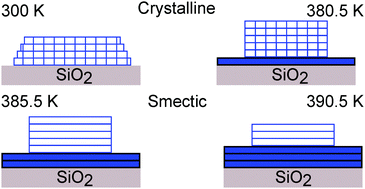Reversibility of temperature driven discrete layer-by-layer formation of dioctyl-benzothieno-benzothiophene films†
Abstract
Film forming properties of semiconducting organic molecules comprising alkyl-chains combined with an aromatic unit have a decisive impact on possible applications in organic electronics. In particular, knowledge on the film formation process in terms of wetting or dewetting, and the precise control of these processes, is of high importance. In the present work, the subtle effect of temperature on the morphology and structure of dioctyl[1]benzothieno[3,2-b][1]benzothiophene (C8-BTBT) films deposited on silica surfaces by spin coating is investigated in situ via X-ray diffraction techniques and atomic force microscopy. Depending on temperature, bulk C8-BTBT exhibits a crystalline, a smectic A and an isotropic phase. Heating of thin C8-BTBT layers at temperatures below the smectic phase transition temperature leads to a strong dewetting of the films. Upon approaching the smectic phase transition, the molecules start to rewet the surface in the form of discrete monolayers with a defined number of monolayers being present at a given temperature. The wetting process and layer formation is well defined and thermally stable at a given temperature. On cooling the reverse effect is observed and dewetting occurs. This demonstrates the full reversibility of the film formation behavior and reveals that the layering process is defined by an equilibrium thermodynamic state, rather than by kinetic effects.



 Please wait while we load your content...
Please wait while we load your content...